Area Rug Cleaning in Folly Beach, SC
Time is an asset you can't afford to lose when you're an average homeowner. Between taking the kids to football practice and piecing together your next presentation at work, there's only so much you can do in one day. And while the weekends were once meant for R&R, today, family life is busier and more hectic than ever.

With so many tasks and responsibilities on your plate, keeping your family's cherished area rugs dust-free, germ-free, and stain-free is easier said than done. For most folks, deep-cleaning an area rug is a chore that must take a back seat to other, more important, tasks. Who wants to spend hours of cleaning area rugs after a long day at work when your kids are hungry? If you find yourself stretched thinner than a bedsheet but still want to maintain the beauty of your home's woven wool rugs, area rug cleaning in Folly Beach, SC, is the solution you need in your life.
Located in the beautiful state of South Carolina, Citrus Fresh Carpet & Rug Cleaning is metro Charleston's premier choice for high-end area rug cleaning. At Citrus Fresh, we understand how stressful it can be to keep up with housekeeping chores like deep cleaning your woven wool rugs. We're here to take that stress off your plate so you can focus on more important things, like cheering on your little ones at practice or picking them up from school.
Service Areas
The Citrus Fresh Area Rug Cleaning Difference
The biggest difference between Citrus Fresh and other area rug cleaners in South Carolina is that we treat your expensive area rugs like they were our own. Unlike synthetic, wall-to-wall carpets, area rugs are often handmade and require an entirely different cleaning approach than other types of carpets. Our team of highly-trained professionals understands that to a "T" and knows that, unlike other carpets, your area rugs hold sentimental value. As such, we treat your area rugs with the care and compassion they deserve.
Speaking of our team, they didn't arrive at Citrus Fresh by accident. They were vetted and chosen to be part of Citrus Fresh. In fact, we make it a point to hire team members that are courteous, friendly, and trustworthy. All our employees are tested for drugs and have their backgrounds checked as well. In addition, Citrus Fresh Carpet & Rug Cleaning Services is:
- Fully Bonded
- Fully Licensed
- Fully Insured
- Textile Pro Certified
- Dedicated to Proper Training
- A Customer-First Business with Years of Experience
Whether your area rug is a family heirloom passed down for generations or a recently-purchased treasure from the Middle East, our team has the tools and training to clean it correctly the first time out. Plus, to ensure the safety of your area rug cleaning in Folly Beach, SC, our passionate techs evaluate every inch of your carpet to develop a cleaning strategy. Then, using their knowledge and experience, our area rug experts follow that strategy to provide you with a highly-effective clean.
Unlike some area rug cleaning services, Citrus Fresh maintains your rug's integrity by cleaning it at our state-of-the-art facility. We'll even pick it up from your house! That way, we can clean it as thoroughly as possible and give it the attention and love it needs. Once your lovely area rug is restored to its former beauty, we'll drop it off at your home, or you can pick it up and bring it back with you to enjoy. Just let us know what works best for your schedule, and we'll cater to you.
The Citrus Fresh Carpet & Rug Cleaning Guarantee
Many area rug cleaning companies refuse to guarantee their work for one reason or another. Citrus Fresh Carpet & Rug Cleaning is not one of those companies. We offer our wonderful customers a guarantee to show them that we're dedicated to making them and every customer happy and satisfied.
If you're not fully satisfied with any service we provide, we will come back to fix the problem for free within seven days from the service date. No if's, and's, or but's. It's really that simple!
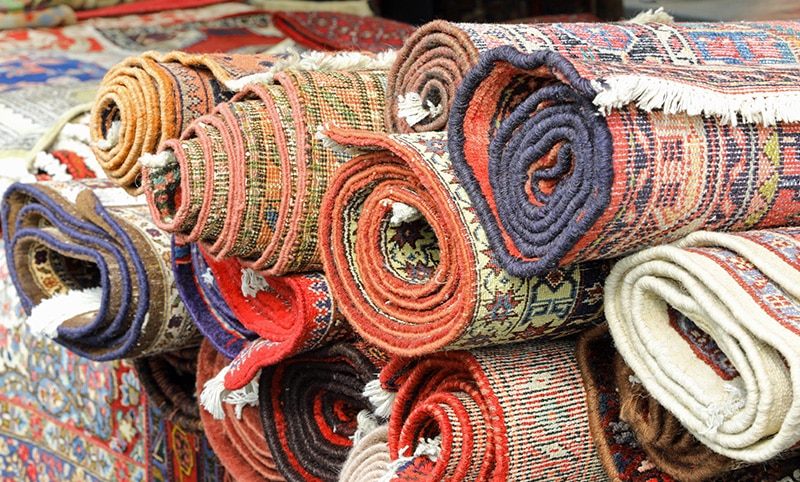
Our Process for Area Rug Cleaning in Folly Beach, SC
At Citrus Fresh Carpet Cleaning, we clean your valuable area rugs in our local state-of-the-art facility. For your convenience, you have the option of scheduling a pickup or delivery service. Alternatively, you can bring your area rug to us and drop it off at our cleaning location. Because every area rug we clean is a little different, no two cleaning applications will be exactly the same. However, the typical cleaning process for an area rug is as follows:

Pre-Inspection and Check In
We begin with measuring and cataloging to provide both accurate pricing and a way to track each rug throughout the cleaning process. We then thoroughly inspect the rug for fiber content, construction, dye stability and any preexisting concerns. We record this information in a detailed report with photographs. Our company will come to your home to pick up your rug, or you may drop it by our shop.



Dry Soil Removal
The vital first step to quality cleaning is dusting. Our state-of-the-art automatic rug dusting machine is specially designed to safely remove hidden embedded dust, sand and soil from the base of the face fibers. It is not unusual for a woven rug to release 2-5 lbs. of this dry material, which if not removed, can cause long term damage.
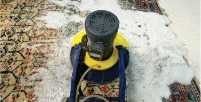
Area Rug Washing
Before the wash process has started, your rug is tested for dye stability and treated accordingly with a dye stabilizer to minimize any bleeding of the dyes. The rug is now ready to be fully washed on our clean and graded wash floor. The pre-inspection determines the appropriate techniques and products to be used for effective and safe cleaning.


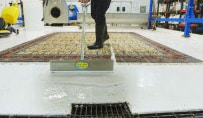
Rinse & Water Removal
Once the rug has undergone its complete wash, it is time to rinse it. Using clean water and a specially designed squeegee. Followed by running the rug through one of the most successful rug-wringers in the world! Not only provides another level of rinsing, but flushes out any extra urine and other contaminants in the rug. It removes over 90% of moisture from rugs in 3 minutes or less. When the rug emerges, it is completely rinsed and merely damp.

Fringe Cleaning
All fringe detail will take place in the finishing stage. Fringe will be extracted, groomed and treated accordingly.



Drying
Rug are hung to finish the drying process. They are enclosed inside our dying tower rack with powerful air movers and dehumidifiers in drying each rug quickly as possible.

Grooming / Delivery
Once fully dried, the rug will be vacuumed and groomed. The pile will be set and it will receive a final post inspection. The rug then will be rolled, nicely wrapped and placed in our clean room to await pick-up or delivery.

Benefits of Professional Area Rug Cleaning
Whether you're on a budget or you have an abundance of free time, you may be thinking about DIY area rug cleaning in Folly Beach, SC. While maintaining your area rugs with regular vacuuming and spot stain removal is important, a complete area rug cleaning requires specialized knowledge, tools, and training. Here are just a few of the biggest benefits of hiring a professional area rug cleaning company like Citrus Fresh:
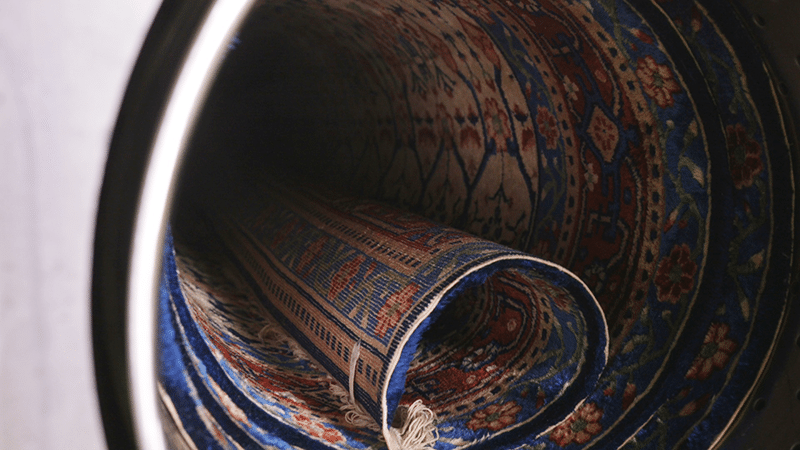
You want your rug soft to the touch
Your rug is submerged and washed with products for wool, then rinsed & spun in professional equipment!
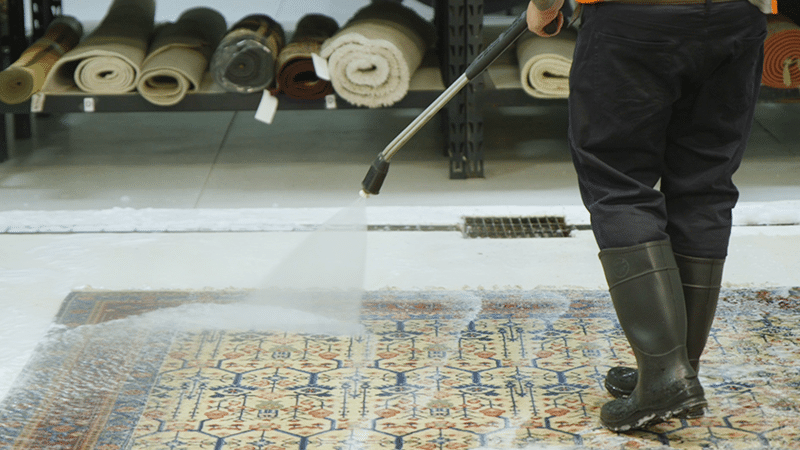
You want to see your rug colorful again
When your rug is washed correctly, you will see that pop of color that has been missing!
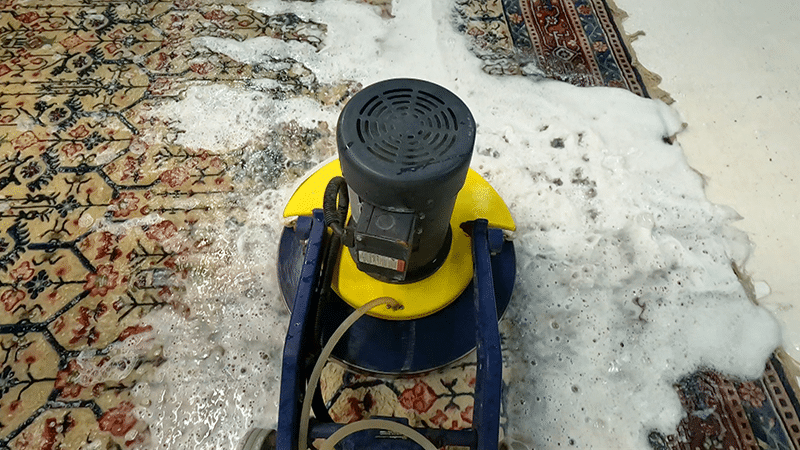
You want all pet accident odors removed
Your rug is submerged under water & flushed to give you Guaranteed Pet Odor Removal!
What About In-Home Area Rug Cleaning in Folly Beach, SC?
At Citrus Fresh Carpet & Rug Cleaning, we offer several carpet cleaning services to our customers. While we're happy to come to your home to clean the synthetic carpets you walk on every day, we must take a special approach with area rugs. The bottom line is that to clean your area rug properly, we must do so in our fully-equipped cleaning facility. We can't travel to your home with the equipment needed to thoroughly clean area rugs that are wool, handmade, silk, etc.
There are many reasons why an area rug must be removed from a home or office to be properly cleaned. Here are three of the most important:
Dust
Most in-home carpet cleaning does not incorporate dusting with synthetic carpets. But with area rugs, dusting is non-negotiable. Area rugs, especially of the wool variety, can hold pounds of dust, mites, dead skin, and other yucky debris. To remove this debris, dust and soil must be removed from the foundation of your rug's fibers. To do this, heavy equipment, a clean facility, and a professional's touch are needed.
Improper Rinsing
Standard in-home carpet rinsing often involves a fiber rinse that can leave residue on high-end area rugs. This residue can lead to fading and yellowing. By bringing your area rugs to our cleaning facility, our team can rinse your area rug more thoroughly. That way, we can release trapped dirt that is trapped in the wefts and warps of your Oriental rug. We can then place your area rug in our wash pit for additional rinsing, using water to flush through your rug from back to front. We then use a specialized squeegee to remove any remaining soil remnants until the water we use runs clear out of your rug.
Knowledge
Your average in-home carpet cleaner will clean your carpet the best way they can with the information they have. As such, they may treat your area rug like it is a piece of carpet. Unfortunately, that can have disastrous effects on your prized area rug.

However, highly-trained area rug specialists have unique knowledge that in-home carpet cleaners aren't required to know. As mentioned above, they also have the specific equipment and building space needed to completely clean an area rug. The owners of Citrus Fresh Carpet & Rug Cleaning were trained to clean Oriental and area rugs by world-renowned expert Lisa Wagner, earning the title "Textile Pro Certified."

Area Rug Pads from Citrus Fresh Carpet & Rug Cleaning Services
In addition to personalized area rug cleaning in Folly Beach, SC, we offer custom-cut area rug pads to fit your area rugs like a glove. Our rug pads act like an insurance policy for high-quality area rugs, even if they're made of materials like wool or cotton. Unlike other rug pads, however, our pads have the ability to soak up unwanted spills.
Most rug pads allow liquids to pass right through them. When this happens, the fluid is trapped between the rug pad and your floor - an incredibly damaging circumstance for your flooring and its finish. Can you imagine what a pool of red wine would do if left to fester underneath your favorite area rug? You could be looking at thousands of dollars of damage.
With rug pads from Citrus Fresh, liquids are moved away from the rug by the absorbent top layer of the padding and are held in place by the rug pad. The pad, which is designed with a moisture barrier, does not allow the spill to reach your flooring. This innovative design doesn't just protect your floors - it protects your area rug better too. As if that weren't enough, the closed-cell technology of these pads helps provide a barrier to pet urine!
We sell Rug Pads - and will custom cut to fit your rugs!
Additional benefits of area rug pads from Citrus Fresh include:
- The Eco Preferred or Eco Value is a Green Label Certified Environmentally Safe Product
- The only "GO GREEN" felt pad on the market.
- Green Label Plus Certified
- Washable
- No Latex Rubber in Eco Products
- Sustainable Eco Friendly - 100% Recycled - 100% Recyclable
- No Odors or Off gassing
- Non-Toxic & Non-Allergenic
- Will not stain, discolor, or mark flooring.
- Great for Radiant Heat since it doesn't degrade
New Closed Cell Technology (CCT) provides a pet urine barrier. Keeps most spills & pet urine from soaking through to ruin your hardwood flooring.
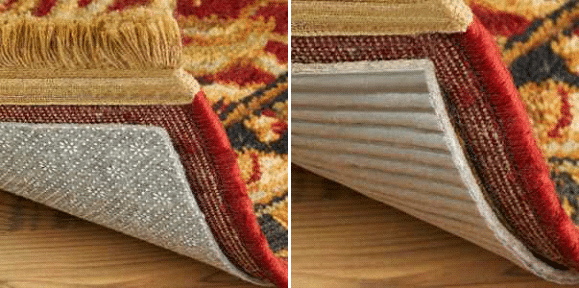
Your Top Choice for Area Rug Cleaning in Folly Beach, SC
You might be wondering, "Who is the best choice for area rug cleaning near me?" One look at our reviews and video testimonials, and the clear choice is Citrus Fresh Carpet & Rug Cleaning Services.
Meticulous in its cleaning and care of fine area rugs, we're proud to provide our customers with safe, reliable, efficient services that protect and restore the appearance of your rugs. Our area rug cleaning methods are incredibly potent and have been proven to clean a wide array of unique area rugs, from the most fragile family heirlooms to sturdier modern rugs.
Good old-fashioned customer service, attention to detail, and a passion for cleaning area rugs make Citrus Fresh your first choice for service and quality. Contact our office today to learn more about our cleaning process or to schedule your area rug pickup or drop-off.
Latest News in Folly Beach, SC
A first-time guide to Kiawah Island and Charleston's barrier islands
Jesse Scotthttps://www.lonelyplanet.com/articles/guide-to-isle-of-palms-and-kiawah-island
If you thought Charleston and its cobblestoned, charming streets couldn’t get any better, we have some wonderful news – there are nearby beaches, too. Kiawah Island, Isle of Palms, Folly Beach and more are all wit...
If you thought Charleston and its cobblestoned, charming streets couldn’t get any better, we have some wonderful news – there are nearby beaches, too. Kiawah Island, Isle of Palms, Folly Beach and more are all within a 45-minute drive, each with its own personal Southern charm. If a dabble in marsh-draped, palmetto-swaying coastal luxury is on your Lowcountry bucket list, you can check it off with certainty.
The islands have their own quirks and delights to keep in mind depending on your needs. For example, Kiawah Island only has one publicly accessible beach, whereas Folly Island – home to Folly Beach – has nearly 50 public beach access points.
Beyond blissful white sands, there’s much more to the barrier island experience, from a pedestrian mall with open-air movie screenings to a county park where migratory shorebirds take a rest. To enjoy these experiences and learn how to plan a first-time trip through this coastal magic, here are some pointers.
When should I go?
Summer is the busiest season in the region, with warm ocean waters and packed beaches. The 4th of July sparkles, with the Folly Beach fireworks being a major draw and the temperatures linger in the 80s. Otherwise, book a fall trip for cooler temperatures – typically hovering in the mid-60s to mid-70s – smaller crowds and a chance to catch the pink Muhly grass in full bloom.
Wildlife fans should time their visit to align with the Loggerhead turtle nesting season (mid-May through October). The winter months are considered the low season with fewer crowds and cheaper hotel rates. With low temperatures in the 40s, you’ll need a wetsuit for an ocean swim or mangrove-dotted kayaking journey. The popular Kiawah Island Marathon – typically in December – is a great way to warm up.
Keep in mind that June through November is the Atlantic hurricane season. If you’re on a coastal journey, keep an eye on serious storms and, if necessary, move inland when advised.
How much time should I spend?
Book a long weekend – ideally four days – to explore each island. This will give you a full day and night in each of the area’s prized locales – Kiawah Island, Folly Beach and Isle of Palms. You’ll have enough time to stroll around Freshfields Village on Kiawah, take in a Saturday surf and yoga class with Shaka Surf School in Folly Beach, and capture a magical sunrise in Isle of Palms with its iconic 1000ft-long pier stretching into the water. Alternatively, choose one island and rent a house for a week to fully kick back and enjoy.
Is it easy to get around?
Whether arriving via plane or train (there is an Amtrak station within a mile of the airport), you’ll need a car to reach and navigate the barrier islands. While rideshare vehicles are readily available in Charleston, they can be tough to book once out at the barrier islands. There are no public transportation options connecting the islands or solely serving each one.
For bikers, Kiawah Island is the best bet. It boasts 30 miles of paved trails and rentals are readily available at trusted local shops like Island Bike & Surf and Seaside Cycles.
Top things to do
Just 20 minutes from the heart of Charleston, this is where the locals come to unwind. A popular activity is for folks to trade their stylish outfits for a wetsuit and ride some waves. Whether you’re a newbie or a regular, there are surf schools – like Shaka Surf School and Isla Surf School – with lessons, summer camps, equipment rentals and more. For the area’s best waves, head to a nook known as the Washout. Post-surf, hit the chilled and welcoming Lowlife bar for southern fare like a pimento cheese spread or perfectly crisped chicken and waffles.
Consider Kiawah Island golf paradise. If you can snag a tee time or lesson at the Ocean Course – which has hosted the PGA Championship in recent years – do it. On-site, grab lunch or dinner at the Atlantic Room, which is renowned for seafood catches with a seasonally-inspired flair. If golf isn’t your thing, Freshfields Village will keep you occupied for several hours. There are nearly three dozen shops and restaurants to peruse, with Islands Mercantile being the spot to pick up a KIAWAH-branded pastel shirt as a memento.
Thirty minutes east of Downtown Charleston, Isle of Palms County Park is the undeniable epicenter of the nearly five-sq-mile island. Within the oceanfront park, there is a rental stand for beach chairs and umbrellas if you'd like to relax and take in the dune-clad landscape.
The spot is primed for a picnic – snag some local fare, like pimento cheese and boiled peanuts – at any grocery store before you arrive. For a luxury al fresco experience, Picnic Charleston will curate an entire setup (advance booking is essential) complete with tablescapes, flowers, a seasonal charcuterie and more. While you’re dining, watch pelicans and egrets swirl by. And, if you’re lucky, perhaps you’ll see a friendly bottlenose dolphin diving through the waves.
Nestled on Wadmalaw Island – just a 35-minute drive northwest of Kiawah – is Charleston Tea Garden. A long, marshy country road culminates in this 127-acre operation. A couple of fun facts: it’s the only large-scale commercial tea farm in the entire North American continent and it is known for its signature American Classic Tea variety, which is a mild black tea variety originally brought from China in the 1700s. Make sure to pop in the gift shop for unlimited tastes of hot and cold teas, spanning green to peach-loaded varieties.
My favorite thing to do
Getting from A to B around these parts is half the fun. Whichever barrier island you land on, going from the historic architecture of Charleston, driving through eerie swampy terrain, and then arriving at a pristine beach is a truly multi-sensory experience. My favorite place to stroll is Kiawah Beachwalker Park – it’s less touristed, super-wide with hard-packed sand, and very dog-friendly. I like seeing all the friendly pups have their day at the beach, too.
How much money do I need?
While barrier island bliss could easily come with a hefty price tag, the region offers a nice balance of luxury and bargain options. As with any beach destination, load up on the essentials – sunscreen, snacks, water – before arrival or face inflated prices for last-minute convenience.
Know your culinary lingo
You’ll see some unique dishes popping up on menus around these parts. A Lowcountry boil often includes shrimp, sausage, corn and potatoes; she-crab soup is a creamy offering with a dash of sherry; and Gullah Geechee refers to the culture of once enslaved West Africans that were freed in the state and migrated to the barrier islands.
Don’t mess with the turtle nests
Come May through October, you’ll see roped-off spots on local beaches from time to time. It’s easy to be curious and want to dig in, particularly kids, but don’t. These areas are protected loggerhead nesting sites and disturbing them can come with very steep fines.
Charleston Is Magical, but Not for the Reasons People Think
Ellen Schmedinghoffhttps://www.afar.com/magazine/how-to-enjoy-outdoors-charleston
Talk to anyone who knows and loves Charleston, and you’re likely to hear about how magical this place is—the dappled light streaming through the live oaks, the pods of dolphins leaping from the river, the succession of pink and white flowers through the seasons. All of these things are alive, because this city owes so much of its beauty to its unique environment. Here, we look at a few ways you can dig a little deeper into the local ecosystem and experience the Lowcountry’s natural wonders.Head to one of Sout...
Talk to anyone who knows and loves Charleston, and you’re likely to hear about how magical this place is—the dappled light streaming through the live oaks, the pods of dolphins leaping from the river, the succession of pink and white flowers through the seasons. All of these things are alive, because this city owes so much of its beauty to its unique environment. Here, we look at a few ways you can dig a little deeper into the local ecosystem and experience the Lowcountry’s natural wonders.
Head to one of South Carolina’s most beautiful beaches
Downtown Charleston sits at the confluence of two rivers—the Ashley and the Cooper—which then pour into the Atlantic Ocean. The metro area is also home to some of the Lowcountry’s finest beaches, in the towns of Folly Beach, Kiawah Island, Isle of Palms, and Sullivan’s Island (all less than an hour’s drive from downtown). Each has a distinct personality, ranging from quirky and lively (Folly) to pristine and preserved (Kiawah), and they’re all wonderful for swimming, fishing, and lounging on the sand. One in particular is worth the trip: Sullivan’s Island.
With streets marked as “stations”—a nod to the stops trolley cars once made as they carried beachgoers out to the neighboring Isle of Palms—Sullivan’s Island is an idyllic, old-school beach town unblemished by hotels and high rises. Instead, the community is dotted with boutiques, restaurants, cottage-style homes, and swoon-worthy yards. Every station provides an entryway to the shore, but Station 16 is the one to aim for, as it leads to the Sullivan’s Island Nature Trail. This 0.6-mile out-and-back route has 650 feet of boardwalk and a number of observation decks that offer opportunities to take in dunes and wetlands populated by various bird species, including ruddy turnstones, oystercatchers, and red knots. With the open sky above, greenery all around, and the sound of waves crashing in the distance, this spot is a slice of heaven that’s easily accessible for people of all ages and abilities.
Hunt for fossils around Charleston Harbor
Charleston is a historic city full of colonial artifacts, but it’s also home to signs of life going back a whopping 33 million years. If you’ve dreamt of being an archaeologist, Charleston’s got a surprise activity in store.
Naturalist Cade Kaufmann grew up kayaking in Charleston Harbor, searching for fossils and shark teeth along riverbanks, sand bars, and beaches. These childhood journeys sparked a lifelong interest for the Charleston Outdoor Adventures guide, who created the company’s Shark Tooth & Fossil Hunting Tour. The four-hour itinerary begins with a boat ride from Folly Beach to Morris Island, where Kaufmann teaches guests how to find and identify an incredible range of fossils during a hike of four to six miles.
“Charleston lies on top of soft, sedimentary fossil layers that suggest that the area was a shallow, warm bay,” Kaufmann explains. “These were not only ideal living conditions for prehistoric sharks, fish, sea turtles, dolphins, whales, manatees, and birds, but also ideal for the preservation of their remains. Over the years I’ve found teeth from mammoths and mastodon, giant shark teeth, huge whale vertebrae, Native American pottery and projectiles, and Civil War relics. Each find tells its own unique story of Charleston’s past.”
Looking to hunt for fossils on your own? Kaufmann advises going at low tide. “Try to find an area with deposits of rocks and shells, and start looking for fossilized teeth and bones,” he says. “And look for the most remote areas to avoid unwanted competition.”
Explore the Lowcountry’s marvelous marshland
Seasonal shifts are subtle along the balmy South Carolina coast, and locals know that the best place to spot the coming of fall is in the marshes, where the dazzling summer green of the tall spartina grass fades to an autumnal golden brown. The colorful flora is among the delights in the marshland surrounding Charleston, which both protects the Lowcountry from the worst impact of storms and also provides a welcoming environment for aquatic creatures, including dolphins, herons, and blue crabs.
The best way to explore this wondrous ecosystem is with the help of a professional outfitter. Coastal Expeditions offers a variety of guided tours, from kayaking and paddleboarding expeditions on Shem Creek (just across the Arthur Ravenel Jr. Bridge from downtown) to sunset eco-tours and stargazing in the Cape Romain National Wildlife Refuge. (The company also rents kayaks and paddleboards.) For its part, Charleston Outdoor Adventures leads the memorable Full Moon Kayak Tour, a two-hour adventure that departs from Bowens Island, traveling through the estuary as day gives way to moonlit night. If you’re more of an early riser, embark on Flipper Finders’ 9:30 a.m. Morning Kayak Tour to enjoy a two-hour paddle through the Folly River as the natural world wakes up around you.
Take a walk in the woods—and see a historic site
For a longer hike, there are plenty of parks within a 30-minute drive of downtown. To the west, along a scenic stretch of U.S. Route 17, is the Ravenel Caw Caw Interpretive Center. The land, which enslaved Africans once transformed from a cypress swamp into an intricate system of rice plantations, is now a wildlife preserve managed by Charleston County Parks & Recreation. It features more than six miles of trails, with elevated boardwalks and a bounty of wildlife: alligators, otters, swallow-tailed kites, bald eagles, and elusive birding bucket-list targets, such as the painted bunting and roseate spoonbill. In addition, the park is a historic site: It’s where the 1739 Stono Rebellion, the largest uprising of enslaved people in the British colonies before the American Revolution, began.
Aside from its historical significance, Caw Caw Interpretive Center park manager Dennis Burgart explains that what makes the site special is its mix of ecosystems. “We have upland forest, salt marsh, swamp, freshwater impoundments from former rice fields, and naturalized tea bushes mixed in,” he says. “Wildlife are drawn to these transition zones and thrive here. When people get past our front gate, they forget how close they are to civilization and are carried away into adventure.”
Another nearby option for adventure is Stono River County Park, an 85.5-acre green space at the foot of the Limehouse Bridge with a variety of highland and marshy landscapes, with 1.5 miles of wooded trails and boardwalks. North Charleston, meanwhile, is home to Wannamaker County Park, which sprawls across 1,015 acres of woodlands and wetlands, with 2.5 miles of nature trails, in addition to a disc golf course, a dog park, and picnic sites.
Ellen Schmedinghoff is a Rhode Island native who writes from her home in North Charleston, South Carolina.
Seawall permits on Folly Beach could be put on pause as city mulls new standards
Anna Sharpe [email protected]https://www.postandcourier.com/news/folly-beach-seawall-moratorium-setback/article_f34cfb82-d2b4-11ef-9f5a-73c1680b144c.html
FOLLY BEACH — City Council gave initial OK to a three-month moratorium on issuing seawall permits until updated construction standards are adopted.Establishing a 25-foot setback line for seawalls on Folly Beach is being considered. If approved, any new seawalls constructed would need such a buffer between the wall and the state baseline, which is determined by the proximity of the first line of...
FOLLY BEACH — City Council gave initial OK to a three-month moratorium on issuing seawall permits until updated construction standards are adopted.
Establishing a 25-foot setback line for seawalls on Folly Beach is being considered. If approved, any new seawalls constructed would need such a buffer between the wall and the state baseline, which is determined by the proximity of the first line of sand dunes.
Introducing a setback line would prolong the life of the beach between federal renourishment projects, like the one completed last summer, officials said during a council meeting Jan. 14.
City Council discussed the idea of establishing a setback in November but voted to send the item to the planning commission to hold a public hearing seeking input on the potential changes to local construction standards.
The baseline is set by the state Department of Environmental Services to mark where the agency's permitting authority begins. It is typically placed at the crest of the most seaward dune.
The state setback line is at least 20 feet landward of this line. By state law, seawalls and other erosion structures are prohibited between the setback and the baseline.
Folly Beach does not have a state setback line. The city allows for seawalls, bulkheads and revetments to be built behind the state baseline.
The oceanside community is exempt from portions of the state's Beachfront Management Act due to the construction of the Charleston Harbor jetties in the 19th century. The jetties block the flow of sand that should be accreting on the beach, which contributes to worsened erosion.
This exemption means the island does not have a state setback line where other beaches do, like the Isle of Palms.
Folly Beach currently allows for seawalls; bulkheads, a type of retaining wall; and revetments, which are sloping structures, to be built behind the state baseline, City Administrator Aaron Pope said. These structures are physical measures to stop or slow beach erosion.
"There is no uniform distance for the seawall to be setback, but it has to be far enough back the entire revetment is behind line. The rocks themselves have to be placed at a certain slope, so the higher the wall the farther back the wall will need to be to allow proper placement of rocks," Pope said.
Creating a 25-foot setback is a recommendation that comes from the city's 2024 update of its Dune Management Plan, a guiding document that aims to restore and preserve the island's dune system.
Between periods of beach renourishment, federal projects completed by the U.S. Army Corps of Engineers, the beach erodes and can expose revetments, which can impact public access to the beach and encroaching past the state baseline.
"When exposed revetments move onto the public beach they can obstruct public access during high tide, when people are forced to walk farther from the ocean because there is no dry sand and they have nowhere to go but over the rocks," Pope said.
The 25-foot setback would reduce the number of potential encroachments while allowing homeowners to continue to construct seawalls. The moratorium will prevent any walls or revetments from being built too close to the baseline and later have to be moved or rebuilt, Councilman D.J. Rich said.
"We've had rocks and people's riprap ending up on the public beach, and the Army Corps has to move all that off," Rich said. "We don't want anybody building now and then encroaching on there, then they just have to move it later on."
Council approved the first reading of the temporary moratorium on issuing oceanfront seawall permits. The moratorium requires an additional reading before it is officially enacted.
If adopted, no permits for ocean-facing seawall permits will be issued until March.
In 2024, the city issued 11 seawall permits. There are two permits currently under review that would not be subject to the moratorium.
The planning commission will hold a public hearing on the seawall setback consideration during its next meeting at 7 p.m. Feb. 7.
Dogs must be banned from a popular Hilton Head beach for the town to start renourishment
Lydia Larsenhttps://www.islandpacket.com/news/local/article299870199.html
Dog owners who stroll a portion of Fish Haul Beach will need to find new sands to walk their four-legged friends as the access rules are changing soon.During a Feb. 4 Hilton Head Town Council meeting, Assistant Town Manager Shawn Colin said that in order to secure the necessary permits to proceed with the beach renourishment project, the town would need ban dogs on a section of Fish Haul Beach.While dogs often enjoy romps on the beach, their presence can be ...
Dog owners who stroll a portion of Fish Haul Beach will need to find new sands to walk their four-legged friends as the access rules are changing soon.
During a Feb. 4 Hilton Head Town Council meeting, Assistant Town Manager Shawn Colin said that in order to secure the necessary permits to proceed with the beach renourishment project, the town would need ban dogs on a section of Fish Haul Beach.
While dogs often enjoy romps on the beach, their presence can be stressful and scary for shorebirds who use the area to nest and the ban is to ensure their protection.
“Until we accept the permits, we can not bid out the beach renourishment project, so we wanted to bring this forward to town council so you know we’ll need to amend the municipal code related to animal activities on the beach,” Colin said to the town council.
The restricted area goes from Fish Haul Creek northwest to the entrance of Fish Haul Beach Park.
Under the current restrictions, dogs aren’t allowed on Fish Haul Beach during summer daytime hours. Outside of that period, dogs are allowed on the beach anytime, but owners must leash or be in control of their dog. Under the new rules, dogs will not be allowed in the restricted area at any time, including the winter months.
The U.S. Army Corps of Engineers issues one of the main permits for the 2025 beach renourishment project, and that process includes an opinion from the U.S Fish and Wildlife Service under the Endangered Species Act. They analyze how the renourishment project would impact endangered and threatened species. On Hilton Head, those species include two types of shore birds, the rufa red knot and the piping plover, as well as loggerhead turtles.
Initially, the USFWS required that a larger beach areas on Fish Haul Beach, parts of Port Royal Plantation, as well as Pine Island be dog restricted areas. In 2024 meetings between the agency, town staff and South Carolina Department of Environmental Services, that area was shrunk to a smaller section of Fish Haul Beach.
The town would need the municipal code change in place before the beginning of construction activity, Colin said. The USFWS also determines the timeline that the beach renourishment project so the heavy construction equipment doesn’t impact nesting birds and sea turtles. The project’s first phase is planned to begin in June 2025.
“We know the first period set by Fish and Wildlife is June to October,” Colin said. “We’re likely to not start the project until much later in the summer season, but we need to make sure we have that code change in place.”
The town would also need to place signs and bouys that indicate the location of the restricted area as well as create a “positive messaging campaign” concerning the changes. Additionally, the town will also need to continue to conduct shorebird surveys.
Town Manager Marc Orlando requested that the council allow him to sign the permits, which Colin projects will be finalized the coming weeks, during the meeting. The council approved this request. During the meeting, Orlando said he will wait to sign the permits until the council moves forward with the municipal code change banning dogs from the section of Fish Haul Beach.
“There are at least five other municipalities along the coast that are looking to do beach renourishment within the next 12 months,” Mayor Alan Perry said. “So timing is of the essence.”
This story was originally published February 7, 2025 at 10:32 AM.
The Island Packet
Lydia Larsen covers climate and environmental issues along South Carolina’s coast. Before trading the lab bench for journalism, she studied how copepods (tiny crustaceans) adapt to temperature and salinity shifts caused by climate change. A Wisconsin native, Lydia covered climate science and Midwest environmental issues before making the move to South Carolina.
Disclaimer:
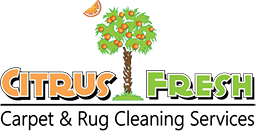

 843-566-4018
843-566-4018